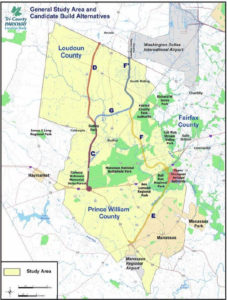by James A. Bacon
A major north-south highway in Northern Virginia took a step closer to reality today when the Commonwealth Transportation Board voted to develop a master plan for a “corridor of statewide significance” that would cut through Prince William, Fairfax and Loudoun counties.
Northern Virginia has the worst congestion in the United States, said Deputy Transportation Secretary David Tyeryar. The gridlock is aggravated by poor access to Dulles airport, which forces people to drive much farther along major arteries like Interstate 95, Interstate 66 and the Dulles Toll Road than they should. The new corridor would better integrate Dulles with the region.
While the route bears a strong resemblance to a proposal for an outer Washington beltway spanning the Potomac River that was scrapped a decade ago, McDonnell administration officials were at pains to say that this project is more limited in scope. The corridor will originate in a southern terminus on Interstate 95, align with the proposed Tri-County Parkway (shown in map), run north past Dulles airport and terminate at Route 7, Tyeryar said. “We will not study a river crossing,” he emphasized.
Tyeryar got pushback, however, from two CTB members who said that the corridor should include a river crossing. “I don’t think we should put artificial limits on what we look at for connecting Dulles,” said J. Douglas Koelemay, who represents the Northern Virginia transportation district. “My goal is river to river. We have connectivity needs with Maryland.”
“The governor of Maryland has been contacted,” said Gary Garczynski, an urban, at-large member from Prince William County. “Senator [Mark] Warner favors a river crossing. It’s in dialogue.”
The only board member to express reservations about the study was James E. Rich, representative of the Culpeper transportation district. It makes more sense to fund smaller projects that can improve mobility in Northern Virginia right now, he said, than to conduct a long study for a megaproject for which no money currently exists, he said. “There are concrete affordable steps to improve access to Dulles.”
Other than Rich, however, when it came to a vote, all CTB members voted in favor of the study. When asked when he could get started, Tyeryar replied that he’d already taken the liberty of putting the project into motion. He promised the board to report back at 6-, 12- and 18-month intervals.
Powerful interests are pushing for construction of a major thoroughfare. The localities along the proposed route have added 300,000 people in the last 10 years, said Robert Chase, president of the Northern Virginia Transportation Alliance. The next two decades will see another 650,000 people settle in the region. That’s nearly a million people — almost the population of Fairfax County. “There is a huge demand for a north-south corridor. If we do something or not, those people will be there.”
Smart Growth representatitves were quiescent at the board meeting. But they have criticized the outer beltway in the past on the grounds that it would contribute to sprawl by opening up vast tracts for development while diverting funds from smaller, more targeted improvements that would do more to reduce congestion.



